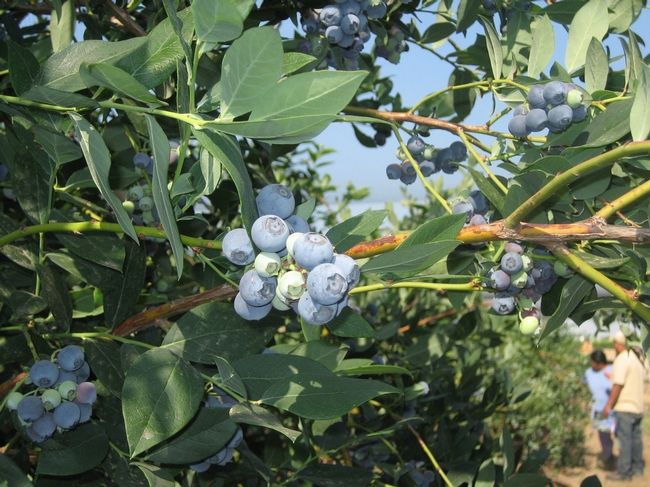UC Food and Agriculture Blogs
Two for One Vegetables
Have you ever noticed that some vegetables provide more than one edible part? I know it's silly, but I get really excited about the idea that I can buy a bunch of beets, eat the beet roots and ALSO use the beet greens for some delicious cooking! What a...
Mosquito Management for Ponds, Fountains, and Water Gardens
[From the June 2013 issue of the UC IPM Retail Nursery & Garden Center News] Many gardeners are adding fountains, ponds, and other water features to their landscapes. Water gardens (Figure 1) are beautiful and calming, but, if not managed...
Senior citizens get nutrition primer from UC program
Alice Escalante is something of a circuit rider in Tulare County. A UC nutrition educator, Escalante travels to rural communities, seeking out groups of low-income senior citizens to offer education that will spur healthier eating.
“I've reached more than 500 adults in the last year – in places like Exeter, Porterville, Cutler and Goshen,” Escalante said. “I go to senior centers, churches, welfare-to-work programs.”
Escalante visits each facility four times for one-hour sessions that include lessons from UC's research-based “Plan, Shop, Save, Cook” curriculum, plus physical activity and a cooking demonstration. Last week, Escalante presented the training to senior citizens in Exeter, a city of 10,000 near the Sierra Nevada foothills.
“When I go around the valley to different sites, a lot of people are familiar with ranch,” Escalante said holding up a bottle of dressing. “They like ranch, they use ranch for everything – pizza, fries, chicken wings and then we drench it on our salads. But did you know just two tablespoons is 160 calories. What if we switched it up, and tried a little honey mustard dressing? Two tablespoons is only 70 calories.”
Escalante explained the difference between good fats and bad fats and she taught the participants best practices for budget-minded grocery shopping.
Look at quantity, store-brand products and convenience to find savings, Escalante advised. Buying in bulk is often cheaper, but for seniors living alone, it may not be the most economical choice.
“You have to look at the size of your household,” Escalante said. “If we are going to save a few pennies buying the larger amount, but it's going to go to waste, it's not worth it. You have to look at the unit price, but also your household.
After leading the nutrition lesson, Escalante encouraged everyone to move to the beat of a Latin tune.
"Come on everybody, let's get up," she called. "You can do it sitting down. If you're sitting down, use your hands. If you can stand, go around in circles."
To close the class, Escalante whipped up a “monster smoothie,” which looks like “something that oozed out of a swamp, but tastes great and has monster nutrition,” said the recipe handout. A key ingredient is kale, a leafy green that contributes vitamin A, vitamin C and vitamin K, plus the minerals copper, potassium, iron, manganese and phosphorus. Find the recipe below the video:
Monster Smoothie
Ingredients
- 2 cups chopped kale
- 1 overripe banana, cliced
- 1 apple, cored and chopped
- 1 cup frozen blueberries
- 1 cup plain low-fat yogurt
- 1/2 cup orange juice
- 2 tablespoons toasted almonds or walnuts (optional)
Directions
- Put the kale, banana, apple, blueberries, yogurt, orange juice and nuts in athe blender. Put the top on tightly.
- Turn the blender to medium and blend until the mixture is very smooth.
- Serve right away or store in a thermos or covered in the refrigerator up to 4 hours.
No Blues for California Blueberries
Summer is upon us, and nothing quite says summer more than eating freshly picked blueberries or using them in delicious desserts. California blueberry growers can find an additional treat – the newly published UC IPM Pest Management Guidelines for blueberry on the UC IPM web site. California is quickly becoming a top producer of blueberries, and the new guidelines can help with management information on blueberry pests such as thrips, light brown apple moth, and spotted wing drosophila with additional information on pesticides and resistance.
It may be hard to believe but as of 1996, blueberry production was limited to colder states like Washington, Michigan, New Jersey, and Oregon, where naturally acidic soils and winter climates suit the traditional highbush varieties. As recently as 1997, California blueberries were only growing on less than 200 acres across the state. According to the latest CDFA statistics, 2012 continued to show what has been an increasing trend for California blueberries, with more than 40 million pounds harvested, $133 million sold, and plantings in more than 4,700 acres spanning San Joaquin, Tulare, Kern, Ventura, and Fresno counties.
In 1995 the University of California Small Farms Program and cooperating farmers started evaluating low-chill southern highbush varieties in San Luis Obispo and Ventura counties. They found that “low-chill” southern highbush varieties offered the most promise for extended season production on the central coast. By 1997, Kearney Agricultural Center trials found that southern highbush cultivars were also well adapted to the semiarid climate of the San Joaquin Valley. Further evaluations identified the best yielding and flavorful cultivars. Initial and ongoing UC Small Farms studies have escalated California blueberry production swiftly up the learning curve, providing California farmers of small to moderate operations a niche in a very competitive market.
Today, California blueberries are harvested from May through July in the San Joaquin Valley and January through May on the central coast. While consumer demands are on the rise and profits can be excellent, producing and harvesting blueberries in California is expensive. It can run over $10,000 per acre to prepare a field because successful cultivation in many areas necessitates soil and irrigation water acidification and adding tons of mulch per acre. Specialized equipment, labor-intensive pruning, and pests like light brown apple moth, thrips, and spotted wing drosophila can add substantially to cost. Therefore, getting the right information and planning is imperative. While the UC Small Farms Program continues to develop field and market research for blueberry production in California, growers can also turn to the newly published Pest Management Guidelines for blueberries.
Carpenter Bees: Mostly Beneficial
Have you seen large black or golden-brown bees foraging in your garden? These could be carpenter bees. Carpenter bees bore into lumber or trees to make nests for their brood and can damage structural wood or leave unsightly holes and stains. Multiple...




